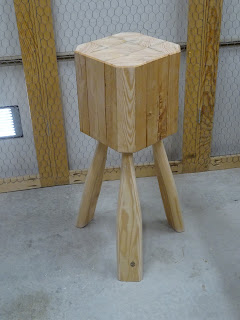A neighbor recently gave me an 8-foot 4x4. Rather than let it lie around in my small shop, I thought I'd make a chopping block from it.
 |
| Chopping block from a 4x4, with 2x4 legs |
Using a divider, I stepped off 9 sections and cut the 4x4 into 9 (roughly) equal lengths, each about 10 5/8". Then I planed some reference faces and edges and glued them up in three sections. After planing the glued sections flat, the three glue-ups were glued together to make a 10x10 chunk of wood that will be my "block".
 |
| The glue-up |
I wanted it to be up off the floor, so the next step was to drill three holes in the bottom. The holes were drilled at about 12° off vertical, using a sightline pointing to a center point. This is end grain, and was a real challenge. A 1" auger bit had little success - the lead screw could not pull the bit into the wood and it stopped cutting, but at least it got the hole started. A Forstner bit in a drill was next - it just didn't cut at all! After thinking about it a while, I spied a rarely-used 1" spade bit in a corner. This did the trick, but it was still not easy and took quite a while. The holes were drilled 3" deep.
 |
| Some layout on the bottom |
 |
| The bits that I tried and the finished holes |
I decided on a final height of about 28-29", and after a few measurements and calculations, took a 2x4 (also acquired from said neighbor) and cut three sections about 22" long. I formed a 3" long, 1" (strong) round tenon on the end and did a little shaping to make the legs look a little better than a chunk of 2x4.
 |
| Three legs |
Before tapping the legs home in their holes, I knocked off the four corners of the block to make it octagonal; not equilateral octagonal, just enough to make the corners look better. I also chamfered the top and bottom edges to reduce inadvertent chipping. After the legs were installed, the feet were scribed to make them sit on the floor evenly.
 |
| With the top level, scribing the feet |
 |
| Sits nice and level |
I suppose if I looked around enough, I could find a piece of a tree trunk to use for a stump. But I generally don't see them around, so this was a good use of a 4x4.
 |
| It's a good height when sitting at this stool |
I don't do a lot of work with a chopping block, so I wondered if this could do double duty. When I need it, I'd bring it into the shop. When I don't, it could be a plant stand on the back patio. Fingers crossed that the wife is OK with that.
 |
| Hmmm ... |
OK, now that I've seen it outside, I don't even need to ask the wife - this looks horrible out there as a plant stand. Back to the workshop it goes.
UPDATE: I've used it now to rough out some stock for my next project, and it has been working out fine. It's faster than sawing or planing the waste, and fun too!
Great use of some common lumber. It turned out great. I have a three foot long section of Douglas fir about 18" round that I kept as a chopping block. We will see if it happens.
ReplyDeleteThanks for the comment, Scott. At three feet tall, that block would probably be a good height for chopping while standing. And 18" (guessing diameter) is quite large - plenty of mass. Interested in knowing if it develops any splits over time.
DeleteI've heard a couple recommendations to make chopping blocks cross grain on top so hatchet doesn't sink in and get stuck. How does the end grain do for that?
ReplyDeleteGuy
I've never heard any such recommendations, though I'm not an expert on the matter. My thinking is that end grain is the way to go because the blade will sink right in between fibers, rather than having to cut across fibers, which will dull the blade way faster. If the blade gets stuck, well that's what a handle is for - you have a lot of leverage to unstick it. End grain is also the historically correct method, as people used to use a section of a log, end grain up.
Delete